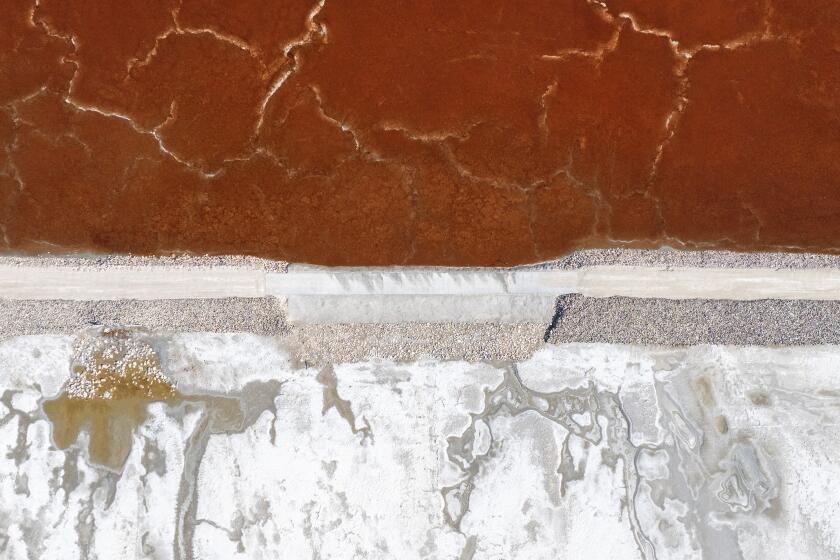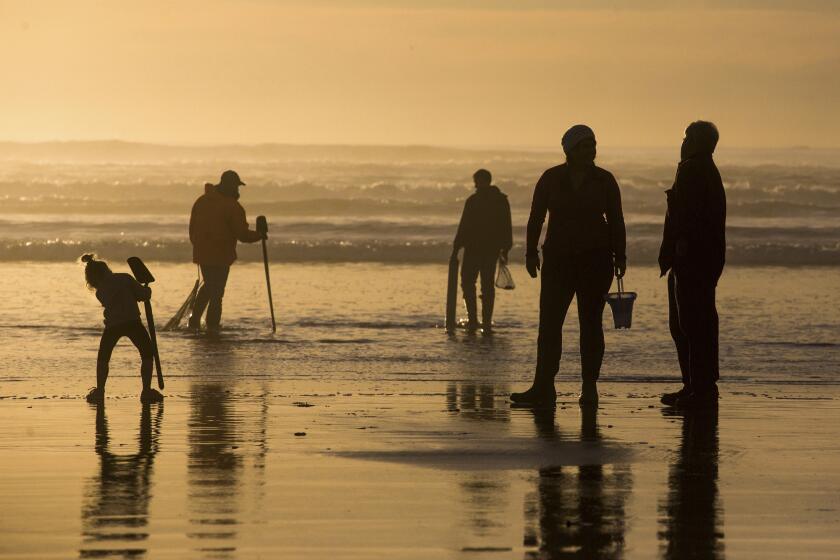Ground Crews Prepare for Atlantis : Space shuttle: Specialists have the job of cooling down the orbiter, extracting the astronauts and getting the craft ready for transport.
The space shuttle’s thunderous sonic boom can rattle your nerves or wake you from a deep sleep.
*
For Ken Pilkington, it’s the starting gun for a five-day work marathon.
“When that sonic boom goes off, I get goose bumps,” said the mechanic, who works at NASA’s Dryden Flight Research Center at Edwards Air Force Base.
The arrival of Discovery, Endeavour, Columbia or Atlantis converts Dryden’s sleepy shuttle operations center, Area A, into a literal boom town.
Edwards has rolled out the red carpet for the shuttle more than 40 times since Columbia, the first shuttle, made its debut flight in 1981. But landings here have been less frequent since Kennedy Space Center at Cape Canaveral in Florida took over as the primary landing site.
Now Edwards is used only as a backup in case of foul weather at Kennedy.
To Pilkington, a married father of two who has a full-time position as a Lockheed contractor caring for shuttle support equipment, the overtime paycheck generated by a shuttle landing is a welcome bonus.
During the 120 hours after a landing, Pilkington and other shuttle support technicians swarm around Area A, where the spacecraft is serviced. In 12- to 18-hour shifts, they power down, secure and load the orbiter atop a 747 for a flight back to Kennedy, where the shuttles are launched.
The shuttle’s most recent visit to Edwards was in March, when Endeavour dropped in. The next landing could come as early as next week with Atlantis.
“It’s go, go, go from the moment the orbiter touches down,” said Pilkington, 32, who lives in nearby Rosamond. “You don’t see much of your family.”
About 20 employees of the National Aeronautics and Space Administration normally work with Pilkington and 40 other contract employees, but NASA flies in an additional 200 or more shuttle technicians from Kennedy to help in the touchdown.
Each task is approached with extreme caution.
“Everybody who works on it knows the dangers involved, and there are dangers on all of it,” Pilkington said. “If you aren’t out there doing what you are supposed to be doing, it can be deadly.”
Those dangers begin immediately upon touchdown. A handful of technicians, nicknamed “canaries,” cautiously approach the shuttle in environmental suits to test the area for leaking fuel gases, which can ignite on contact with oxygen.
At a safe distance, about 700 feet, Pilkington waits in a mobile air-conditioning and cooling unit, one of about 150 pieces of support equipment to be attached to the shuttle.
When the all-clear is given, Pilkington moves in, wearing flame-retardant coveralls. He hooks up the air-conditioning unit, which pumps Freon at 16 gallons a minute through a hose to cool the shuttle’s systems. The work is crucial to the astronauts still inside the cockpit.
“If we don’t cool it off,” Pilkington explained, “the temperature in there can reach 130 degrees for the crew.”
Temperatures on the shuttle’s exterior can be deadly, too. Technicians must stay at least 50 feet away from the hot landing gear for 45 minutes after landing.
“It gets hot enough to blow the tires off,” Pilkington said. “Rubber shrapnel can fly around like 20 shotguns going off at once.”
Several hours pass before the ship is safe enough to tow to Area A, where the shuttle is prepared for mounting on a 747. Only then does Pilkington get a break. After a quick--and mandatory--eight-hour sleep at home, he’s back on the job for his most hazardous shift of the operation.
Before the shuttle can be lifted atop the 747, Pilkington must purge the rest of the explosive liquid fuel from the orbiter’s systems. Any escaping fumes are so dangerous--even a rusty nail can ignite them--that no one but Pilkington and a handful of other technicians is allowed within 1,500 feet.
“If you breathe the fumes, you die,” said Pilkington, who wears a sealed environmental suit and breathing apparatus during the purging operation. “Your lungs blister and they fill up with liquid and you suffocate.”
But the job that makes Pilkington most nervous is next on the list--he must work blindly with four joysticks to operate the crane that lifts the 2,250-ton shuttle atop the 747.
Unable to see the three attachment points on top of the jet, Pilkington must rely on a spotter. The job can sometimes be made even more challenging by desert winds rocking the suspended orbiter.
“It’s scary enough when the weather is calm,” Pilkington said of the eight-hour procedure. “With the wind, it’s like flying a big kite. If you damage the orbiter, you can impact the space program and put you and everybody else out of a job.”
For Pilkington, the tension does not let up until the secured, piggybacked shuttle takes off for Florida. But he will not really relax until he sees it again.
Like many NASA employees, Pilkington continues to worry about his future in the space program. When Challenger exploded in 1986, he lost his job as a shuttle technician at Vandenberg Air Force Base. Two and a half years passed before he could get another job in the space business, this time at Kennedy. He moved back to California in 1989 to work at Dryden.
Although the shuttle has landed at Edwards in five of the last seven missions, there is no knowing when it will return.
“We used to get the shuttle in here eight to 11 times a year,” said Pilkington. “Now we only get it a few times a year.”
Recently, the House of Representatives proposed slashing 300 Dryden positions to make NASA smaller. But NASA/Dryden Director Ken Szalai said none of the cutbacks are expected to affect Dryden’s shuttle-related jobs. Other streamlining measures considered by NASA, however, could affect contract workers like Pilkington.
Pilkington boils it down to: “This has got to be one of the most stressful types of jobs as far as worrying about keeping your job.”
For now, the people who work at the tiny patch of desert known as Area A will continue to tend to business, watch the skies and listen for the sound of thunder.
More to Read
More to Read
More to Read
Start your day right
Sign up for Essential California for news, features and recommendations from the L.A. Times and beyond in your inbox six days a week.
You may occasionally receive promotional content from the Los Angeles Times.






